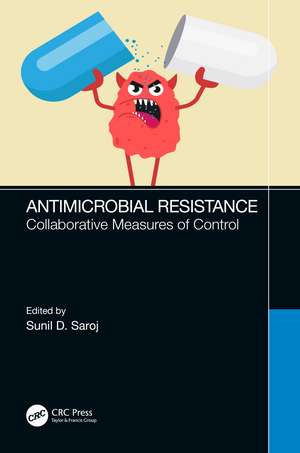Antimicrobial Resistance: Collaborative Measures of Control
Editat de Sunil Dasharath Sarojen Limba Engleză Hardback – 3 aug 2022
Preț: 904.48 lei
Preț vechi: 1103.03 lei
-18% Nou
Puncte Express: 1357
Preț estimativ în valută:
173.07€ • 188.59$ • 145.84£
173.07€ • 188.59$ • 145.84£
Carte tipărită la comandă
Livrare economică 23 aprilie-07 mai
Preluare comenzi: 021 569.72.76
Specificații
ISBN-13: 9781032321615
ISBN-10: 103232161X
Pagini: 364
Ilustrații: 18 Tables, black and white; 18 Line drawings, black and white; 18 Illustrations, black and white
Dimensiuni: 156 x 234 x 21 mm
Greutate: 0.83 kg
Ediția:1
Editura: CRC Press
Colecția CRC Press
ISBN-10: 103232161X
Pagini: 364
Ilustrații: 18 Tables, black and white; 18 Line drawings, black and white; 18 Illustrations, black and white
Dimensiuni: 156 x 234 x 21 mm
Greutate: 0.83 kg
Ediția:1
Editura: CRC Press
Colecția CRC Press
Public țintă
Postgraduate and ProfessionalCuprins
Preface
Acknowledgment
Disclaimer
Contributors
List of Figures
List of Tables
Microbial Threats - The AMR pandemic
Diversity in the Development and Transmission of AMR
Alternatives to Combat AMR: Hunt for Novel Antimicrobials
Antimicrobials in Growth and Development
Antimicrobial and Antibiotic Resistance in Developing Countries: Health Economics, Global Governance, and Sustainable Development Goals
Disease Economics: Economic aspects of Anti-Bacterial and Anti-Microbial Resistance: Comparative analysis of Europe and other world regions
Leveraging Health Diplomacy in achieving AMR Policy Coherence
AMR policies and Implementation issues: Developed vs Developing Countries
Implementation Challenges in Healthcare-associated Antimicrobial Resistance Prevention and Control in India
Combating AMR through Behavior Change : Role of Higher Education Institutes
Behavioural Change: Role of NGOs to Combat AMR
Measures in Preserving the effectiveness of Existing Antimicrobials
Technology Solutions to AMR: Focus Paediatric Population
Human resources capacity building for AMR Stewardship programme
Combating AMR- One Health Approach
Index
Acknowledgment
Disclaimer
Contributors
List of Figures
List of Tables
Microbial Threats - The AMR pandemic
Diversity in the Development and Transmission of AMR
Alternatives to Combat AMR: Hunt for Novel Antimicrobials
Antimicrobials in Growth and Development
Antimicrobial and Antibiotic Resistance in Developing Countries: Health Economics, Global Governance, and Sustainable Development Goals
Disease Economics: Economic aspects of Anti-Bacterial and Anti-Microbial Resistance: Comparative analysis of Europe and other world regions
Leveraging Health Diplomacy in achieving AMR Policy Coherence
AMR policies and Implementation issues: Developed vs Developing Countries
Implementation Challenges in Healthcare-associated Antimicrobial Resistance Prevention and Control in India
Combating AMR through Behavior Change : Role of Higher Education Institutes
Behavioural Change: Role of NGOs to Combat AMR
Measures in Preserving the effectiveness of Existing Antimicrobials
Technology Solutions to AMR: Focus Paediatric Population
Human resources capacity building for AMR Stewardship programme
Combating AMR- One Health Approach
Index
Notă biografică
Dr. Sunil D. Saroj (Associate Professor, Symbiosis School of Biological Sciences, Symbiosis International (Deemed University), India) During my Ph.D. in Microbiology from the Bhabha Atomic Research Centre, India, I was exposed to the fascinating life of microbes. Bacterial pathogens have efficient mechanisms to overcome the stress that could affect their growth and survival. The stress factors include both growth-promoting and growth-inhibiting molecules. The biggest challenge the bacterial pathogens must face is from antimicrobials, bacteriophages, and the host immune system. In nature, these bacterial pathogens are present in close association with other bacteria and their hosts. To overcome these challenges and preserve their existence, the bacteria have developed communication systems, wherein they share chemical and genetic information with the other bacteria. The role of these interspecies communications in virulence and antimicrobial resistance was pursued further during my post-doctoral experience at the Chiba University (Japan), Emory University (USA), and Stockholm University (Sweden). I understand that the issue of antimicrobial resistance could not be resolved by just discovery of novel antibiotics; additional novel intervention strategies are required.
Descriere
We describe the concerted efforts undertaken by global communities to combat antimicrobial resistance in detail. The most efficient strategy could be a behavioral change towards indiscriminate consumption, usage, and prescription of antibiotics.
